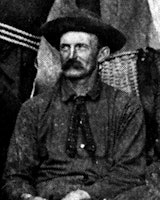
1904 - 1921
Adirondack Camp
The Early Years
Embark on a captivating journey through time as you explore our extensive collection of documents dating back to the early 1900s, unraveling the rich tapestry of Adirondack Camp’s beginnings. This handpicked selection includes a mosaic of letters, evocative photographs, insightful articles, and more, offering a profound glimpse into the formative years of Adirondack Camp. These serve as portals to a bygone era, unveiling the essence of our camp’s origins and the enduring traditions that have left an indelible mark on its legacy. Join us on this exploration as we unearth the stories, memories, and experiences that have woven the intricate fabric of Adirondack Camp’s history.

Dr. Elias Brown
Founded in 1904 by Dr Elias G Brown, Adirondack Camp started with just eight campers. Dr Elias G Brown was a graduate of Columbia University and the College of Physicians and Surgeons, a man of broad educational experience and a Pioneer in the summer camp movement in this country.
Elias Brown was an early leader in the American Summer Camp movement, where he resided as President of the American Camp Association from 1911-1912.
Along with his wife, Mrs Adelaide Brown, they built into the life of the camp certain ideals of character and conduct that have endured to this day, which make Adirondack Camp so distinctive among the camps of the country.
Through his work as a physician and teacher, he became extremely interested in the moral and intellectual development of young and adolescent boys. He felt that the rugged outdoor experiences of camping would help boys develop independence, self-confidence, courage, and the other virtues embodied in the camp’s 10 values that today Adirondack’s boy and girl campers still see proclaimed on wooden plaques hanging prominently in the Mess Hall.
From The Archives
August 26th 1905 marked the first Water Carnival hosted by Adirondack Camp. The Water Carnival was open to any boys on Lake George to compete at no cost!
On their journey home, campers had the opportunity to choose from this farewell breakfast menu, while those heading up the Hudson could select their dinner options from the offerings provided by the C. W. Morse.


In the summer of 1909, Adirondack Camp established The Order of the Adirondack Camp Eagle. Known today as simply an “Eagle,” this coveted prize is the highest honor one can earn at Adirondack Camp. While the criteria has changed slightly over its 112-year-old history, the Adirondack Eagle nevertheless remains one of the oldest and longest-running summer camp award in the world.

1909: The Original Eagle
The original 1909 criteria for earning an Eagle (a.k.a. admittance to the order) was based on a general “personal standard” including the likes of promptness, neatness, following camp rules, and erect posture at meals. A camper’s level of excellence determined which tier they could earn:
- Bronze Eagle - Coming up to the standard
- Silver Eagle - “Especially high standard”
- Gold Eagle - “Especially high standard” including swimming a hundred yards, do the 12 ft high dive, be able to row well, canoe skillfully, recognize and name 25 trees, pass an exam on nature, camping, and woodcraft, as well as answer questions on physical training and care of the body.
It was emphasized that even the youngest and smallest camper could earn a Gold Eagle. Back then, any camper could earn any level of Eagle regardless of age or line.
According to the 1910 booklet, over two-thirds of boys earned a Bronze Eagle, three boys earned a Silver Eagle, and one boy earned the very first Gold Eagle during the 1909 summer.
To obtain the Gold Eagle, a boy must not only have such a good record, but he must have made the most of his summer in camp, and have learned much about nature and woodcraft and have skill along many lines, and courage.
1920s Booklet
Changes over the Years
For many summers, all campers, regardless of age or line, could earn any of the three Eagle awards. But with the introduction of the Braves Code of Honor and changes to the plaques, the criteria of what needs to be accomplished/learned/memorized (and by who) has evolved over the years. However, staff voting, embodiment of core values, and “making the most of the summer” have always been at the foundation of the Adirondack Eagle award. Additionally, one’s impact on camp is also taken into account. Former Director/Owner Bill Dooley suggested the idea that in the earlier days for Gold - a camper’s impact on the entire Camp, for Silver - impact on the camp line, for Bronze - impact at the cabin level.
By the 1950’s, each Adirondack Eagle tier became tied to a specific age group; Junior Campers could only earn a Bronze Eagle, Intermediate Campers could only earn a Silver Eagle, and Senior Campers or Staff could only earn a Gold Eagle. This change was done intentionally to better recognize the unique achievements of specific age groups.
The Adirondack Eagle Today
Today, the Adirondack Eagle is still a tradition and a high honor awarded to many deserving campers and staff each summer. Our ten plaques remain the main basis for the award but service to camp, accumulation of activity points, passing of silence and memory tests, and overall impact all factor into determining who earns an Eagle. At the end of each session, camp gathers together for a joyous celebration where speeches are spoken and tears are shed as we honor and induct new members to the Order of the Adirondack Camp Eagle.













